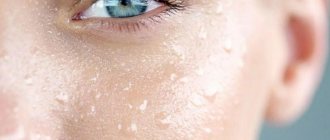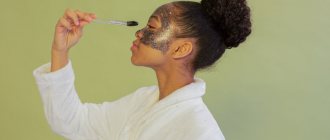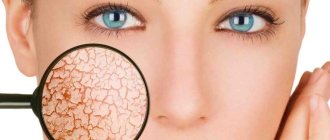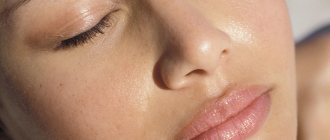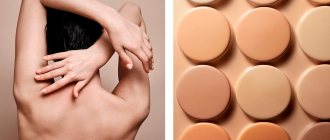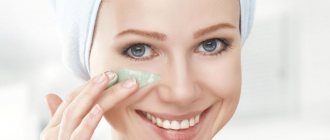First of all, let's clarify the symptoms. Peeling on the fingers or feet means dry skin, the formation of superficial blisters, and lamellar detachment of the skin.
Often, red, “tight” skin is visible under the peeling top layer. As part of self-medication, parents often resort to ointments, which gives a short-term improvement, but within 24 hours the child’s condition worsens again.
As with any symptom, we recommend making an appointment with a dermatologist rather than treating yourself. There are many diseases and ways to treat them.
Similar symptoms give:
- atopic dermatitis; - contact dermatitis; - eczema; - exfoliative keratolysis; - mycosis; - endocrine diseases; - allergic reactions; — lack of vitamins A and E; - incorrectly selected clothes; — violation of hygiene; — fungal diseases; - and many more reasons, with different tactics for their treatment.
Causes
Itching, redness, cracking of the surface, extremely uncomfortable sensations - any of us are familiar with this condition of the epidermis.
For some, a noticeable deterioration is associated with hormonal levels, for others - with cold weather (they often talk about an allergy to cold, although in its pure form it is rare). Only a thorough and comprehensive diagnosis will help answer the reason for the deterioration of the condition. Many patients come with the question: if the skin of the body is very dry, then what should be done? What means to choose to get rid of the problem? However, the doctor will first of all find out why it occurred.
There can be many “triggers”. Let's list some of them:
- Exposure to external factors, including sunlight, air conditioning, temperature changes, and so on.
- Age-related changes (senile xerosis).
- Lack of vitamins, including A, E and C. They are often called the “secret of youth,” although there is no secret in their action. These important components fight antioxidants, maintain the balance of the epidermis and its tone.
- The innate physiological characteristics of the body often answer the question of why the skin becomes dry. This is a so-called constitutional disorder, which is often observed in childhood, when parents of children aged 2 years and older pay attention to poor epidermis.
- Xeroderma is a pathological situation; defects are mainly visible on the face and flexor surfaces. In this condition, the permeability of the epidermal barrier is impaired.
- Allergic reactions.
- Various diseases, including fungal ones.
- Dermatoses also become a factor in the patient developing dryness, and the causes are called differently: contact and allergic, ichthyosis, psoriasis, but all of this is one class of pathologies.
What are the effects of COVID-19 on the skin?
Today, there is no person who has not heard about COVID-19.
Unfortunately, every day, more and more people come face to face with the virus. And then they struggle with the consequences, which can be very different. And such consequences may not make themselves felt immediately, but even after 2-3 months after suffering from COVID-19. Today, podologists, medical pedicurists and manicurists note the presence in their patients of the appearance of excessive or not typical before the disease, dry skin of the feet and hands, peeling, as well as the formation of keratinization, even microcracks. In some cases, even the appearance of deeper cracks is observed. In advanced cases, cracks develop into open wounds.
Pathways to treatment, supportive care and prevention may vary. But the result must be as effective as possible. This will help maintain not only the beauty of your skin, but also your health!
Signs
It would seem that the fact that you have difficulties with the epidermis is understandable without additional explanation. However, there are a number of symptoms that are often not paid attention to, while they serve as a kind of “bell” that you need to check your health:
- after washing there is a feeling that the face, body or hands are “tight”;
- red spots appear;
- itching begins, which causes serious discomfort;
- Cracks and scratches easily form on the surface.
If you have very dry skin on your body, your doctor will tell you what to do. Unfortunately, often a simple change of cosmetics is not enough; comprehensive measures must be taken: change your diet, give up bad habits, monitor which products and materials may cause unpleasant reactions, identify medications that require caution when taken.
The principle of combating the manifestations of peeling
In certain cases, the appearance of pathological detachment of the epidermal layer develops against the background of the following diseases, which require specific treatment to eliminate the cause of the development of the pathology, and as a result, peeling of the skin disappears:
- seborrheic skin lesions;
- psoriasis;
- systemic lupus erythematosus;
- ichthyosis;
- dry erythema;
- ringworm and its varieties;
- scarlet fever;
- skin damage due to fungal infection and other conditions.
The development of pathology can be stopped on your own by using appropriate products for local application, maximally nourishing and moisturizing areas of the skin that are subject to the process of active exfoliation. In case of nutritional disorders, additional intake of fat-soluble vitamins helps restore the natural balance of cell layer renewal.
But if the condition worsens or the cause of the signs of pathology is unclear, you should consult a dermatologist who will competently conduct a diagnostic examination, which will help determine the most appropriate course of treatment. The main goal of diagnostics in this case is to exclude the presence of an infectious pathogen of any kind, which requires the subsequent use of specific treatment.
Useful information on the topic:
- Calling a dermatologist to your home
- Fungal infections
- Rash on the body
- Sexually transmitted diseases
- How to get tested
- Wart removal
- Removal of condylomas
- Tests for STIs
- Removal of papillomas
- Skin rash
- Pyoderma
- Skin structure
- Mushroom tests
- Diagnosis of sexually transmitted infections
Differences between dermis types
To choose the right caring cosmetics, you need to know what you are dealing with and what specific features you have. There are four types in total:
- dry;
- fat;
- combined;
- normal.
These characteristics are determined by genetics, but lifestyle, environmental factors and health play a huge role. To find out which epidermis you have, do a simple test. Clean your face with a mild cleanser, pat dry with a towel, and do not apply any cosmetic creams or serums. Assess the external shine after about an hour.
First type
After washing your face without using moisturizing ingredients, you may feel some tightness. When you blot with matting wipes, you notice that there are no traces of grease left on them. This means that you have dry skin on your body - the reasons, as we have already said, lie in genetics, but improper care and lifestyle usually aggravate the problems.
As a rule, the basis for their manifestation may be a lack of lipids; the protective layer on the surface becomes thinner and becomes permeable. Unfortunately, such features lead to the fact that with age, deeper and more pronounced wrinkles appear on the face, as the epidermis loses its plasticity and ability to replenish volume. Creases occur more easily and last longer.
Second type: normal
In the modern world, where we are influenced by dozens of unfavorable factors, it is not so easy to meet a person with this type. Even if the sebaceous glands are naturally balanced, many circumstances, including health conditions and the use of cosmetics, can disrupt the harmony. And in this case, the doctor hears the question, why is the skin on the face very dry? Normally, sebum secretion occurs evenly and there is no shine. As a rule, the pores are not enlarged, small, blood circulation is good, the complexion is even, the texture is smooth and silky, there is no inflammation or acne. The epidermis is not sensitive, but with age it usually becomes denser, easily injured, itching and peeling occur, areas whose condition causes concern. Then patients turn to a dermatologist or cosmetologist with the question of how to get rid of dryness.
Third type: fat
If, after performing a home test, you see that the cleaned surface begins to shine within an hour, and pronounced traces of grease remain on the matting paper, then you have this type. The reasons for increased sebum production, in addition to congenital characteristics, may be:
- hormonal imbalance;
- use of certain drugs;
- stress;
- cosmetics that lead to the formation of comedones, etc.
Folk remedies for treating dry skin on hands and feet
Products from the refrigerator help if the cause of dryness lies in external factors and is leveled by restoring the fatty film. Write down effective recipes:
- wash your hands and feet with warm water without soap. Soak thick disposable wipes in sunflower oil and wrap your limbs. Remove after an hour, dry with a towel, but do not rinse. Do the procedure at night every day for a month;
- Boil two potatoes and grind in a blender. Add 2 drops of olive oil and lemon juice. It will whiten spots on the skin of your hands and feet. Apply a thick layer to dry areas and wrap with gauze. Rinse off after 20 minutes, lubricate with cream;
- Buy coltsfoot leaves at the pharmacy, brew, strain the juice. Mix it with equal amount of milk. The solution can be prepared for several days. Lubricate problem areas every time you get ready to leave the house. It is not necessary to apply cream on top;
- before the start of winter, lubricate your hands and feet with olive oil: this will prevent peeling;
- Apply warmed honey to the skin of your hands and feet. To avoid getting dirty, wrap it in plastic. After 10–15 minutes, rinse off. Honey removes redness and saturates the skin with nutrients and moisture.
Types of dryness
Problems with the epidermis are different: some suffer from constant discomfort, others develop unpleasant cracks and roughness in the cold, others complain of pockets of itching and burning. All this can be a consequence of various circumstances, including errors in choosing care, errors in nutrition and various factors that provoke allergies and dermatitis. Many women turn to their doctor with the question: very dry skin on the body - what to do? First of all, it is necessary to establish what type of problem a particular patient is:
- constitutional;
- acquired;
- pathological
Atopic dryness
This condition is also called endogenous eczema and is the result of a chronic disease that constantly recurs, accompanied by itching, rashes, and significant deterioration of the skin. The disease is not contagious, but can be inherited. Atopy is characterized by periods of exacerbation and remission, when there are no negative manifestations. However, this does not mean that the pathology has disappeared on its own; one should not relax in such a situation.
If you are worried about atopic severe dry skin of the body, the reasons are most likely a genetic disorder. The synthesis of filaggrin, a protein that is involved in the formation of a protective barrier, is imbalanced. Therefore, if parents have dermatitis, then with a high probability it will manifest itself over time in subsequent generations.
Quite often, the precursor to painful peeling is diathesis in childhood. Typically, every tenth child suffers from this disease, while among adults the disease occurs in approximately 1% of cases. Often these patients also struggle with asthma or chronic rhinitis. Allergic diseases aggravate the situation - this is already a violation of the immune system. The problem is also aggravated by climatic conditions, household pollution, frequent friction and pressure on parts of the body.
Acquired
It occurs as a result of exposure to a number of negative factors. These include:
- ultraviolet;
- temperature difference;
- ambient air conditioning, too active operation of heating radiators;
- improper care using aggressive agents;
- therapy, including the systematic use of creams containing retinoids;
- chemicals (for example, if you have dry skin on your body, the reasons may be due to production factors);
- incorrectly selected or performed cosmetic procedures.
Senile
The loss of moisture is prevented by the so-called epidermal barrier. Cells tightly adjacent to each other, epithelial cells, prevent water from evaporating. Helps maintain the integrity and reliability of this boundary, sebum, which additionally gives elasticity.
The sebaceous glands work less actively over the years, and age-related changes in metabolism lead to the following:
- atrophy and decreased elasticity of the outer integument;
- hydrobalance imbalance;
- the formation of unwanted formations, including age spots, spider veins and comedones;
- the appearance of wrinkles;
- pronounced flabbiness;
- loss of clarity of facial contours.
Treatment and prevention of dry skin of hands and feet
If dryness does not go away for a long time, folk remedies and creams do not help, visit a doctor. The therapist will listen to the problem and take standard tests that will allow you to understand which doctor to refer you to. Prolonged manifestation of dry skin, accompanied by cracks and peeling, is a clear signal of disease. What exactly it is, doctors have to find out.
During treatment, follow preventive measures:
- After washing your hands and feet, dry them thoroughly with a towel. Especially between the fingers;
- lubricate with rich cream: it retains moisture inside the cells;
- before going outside, apply sunscreen cream to visible areas;
- Do all housework with gloves;
- change your socks every day;
- drink at least 1.5 liters of water daily.
If, after examination, the doctor identifies dermatological problems, begin treatment. Do not use medications based on experience and intuition. Listen to the doctor, and then dry hands and feet will go away quickly and painlessly.
Degrees of development
The disease can have different levels of severity. The moderate stage gives a feeling of tightness, the epidermis becomes rougher, irritated, and elasticity decreases. Very high severity leads to peeling of scales, areas of severe irritation, pimples, and itching appear on the face and body. Some areas, such as knees and elbows, tend to be particularly dry - these areas are particularly rough and may develop rough calluses.
The doctor will advise you on what exactly needs to be done - in some cases it is necessary to use not just care products, but medications. They should be prescribed exclusively by a specialist: even a pharmacist at a pharmacy does not always recommend suitable medications. An allergy that joins the irritation that torments you can lead to serious injury that will have to be treated longer and in more radical ways. The doctor will prescribe ointments that are suitable individually.
Medicines that may cause a reaction
Hand-foot syndrome
The following medications may cause hand-foot syndrome.
- capecitabine (Xeloda®);
- Doxorubicin (Adriamycin®)
- Fluorouracil (5-FU®)
- Liposomal doxorubicin (Doxil®)
- Cytarabine (Cytosar-U®)
Palmoplantar skin reaction
The following medications may cause hand-foot reaction.
- Sorafenib (Nexavar®)
- Sunitinib (Sutent®)
- Cabozantinib (Cometriq®)
- Regorafenib (Stivarga®)
- Axitinib (Inlyta®)
- Pazopanib (Votrient®)
- Vandetanib (Caprelsa®)
- Vemurafenib (Zelboraf®)
- Dabrafenib (Tafinlar®)
to come back to the beginning
Diagnostic methods
To find out what causes very dry facial skin, how to treat dry body in women and men and find the causes, it is necessary to conduct a comprehensive examination to treat the patient, which includes:
- clinical and biochemical blood tests;
- consultation with a dermatologist and cosmetologist;
- study of hormonal status;
- allergen analysis and so on.
The full list of necessary diagnostic tests depends on the individual condition. Root causes, in particular, may be related to stress, phase of the life cycle, and so on.
Benefits of a private medical appointment
The result of seeking help from a dermatologist at a private specialized institution is the provision of not only advisory assistance at the appointed time, but also a full range of examinations with further implementation of the necessary treatment procedures. This fact greatly facilitates the implementation of all actions and provides comfortable conditions for completing the prescribed procedures.
And our Help Desk for private clinics in Moscow “Your Doctor” will help you find the right medical center that is convenient for visiting, which contains all the required data, allowing you to immediately make an appointment at a suitable time or arrange a call to a dermatologist at home.
Publication date: 2020-01-07
Useful information on the topic:
- Diagnosis of skin diseases
- Treatment of skin diseases
- Dermatology - the science of skin diseases
- How to consult a dermatologist
- Prevention of skin diseases
- Dermatologist appointment
- Examination by a dermatologist
- Pediatric dermatologist
- Skin doctor
- Paid dermatologist
This article is posted for educational purposes only and does not constitute scientific material or professional medical advice.
Treatment
You can often hear that if you are faced with a similar problem, the most important thing is to achieve proper, deep and constant hydration. However, this is not the only recipe for getting rid of difficulties. In general terms, the line of behavior is correct, but often it is necessary to get rid of the factor that provokes the deterioration of the situation, and this is why tests are prescribed and examinations are carried out.
After diagnosis, the doctor will draw up a list of measures on what to do if your body skin is very dry. As a rule, it begins with drawing up a balanced diet and establishing a drinking regime. You should also try to avoid the influence of negative environmental phenomena: do not wash your face with hard water, avoid exposure to direct sunlight, and do not be in the wind.
It is important to remember that lifestyle changes, including quitting smoking, also have a beneficial effect on the condition of the epidermis.
If dryness is associated with disruption of any organs and systems, including endocrine and digestive, treatment is carried out by a specialized specialist in contact with a dermatologist.
Why does skin peeling occur?
A disruption in the natural balance of renewal of the cellular structures of the skin can be observed for a number of reasons, the impact of which provokes a pathological deviation. Among them, the following should be highlighted:
- changes in ambient temperature;
- manifestation of an allergic reaction to the external use of care products;
- existing skin diseases;
- unbalanced diet, which is associated with the lack of fat-soluble vitamins necessary for the skin;
- natural aging of the surface layer;
- hereditary predisposition.
Thus, the causal effect contributes to a change in the ratio of the rate of keratinization of epithelial cells with their rejection, which leads to the manifestation of typical signs of skin peeling:
- itching;
- change in skin turgor;
- the appearance of a hint of hyperemia;
- presence of relative pain syndrome;
- formation of small cracks on the surface.
Care
Additionally, the following procedures are recommended:
- oxygen therapy;
- ozone therapy;
- magnetic therapy;
- vitamin injections;
- cell mineralization;
- laser therapy and so on.
All procedures are combined with the use of high-quality caring cosmetics recommended by a specialist. It is recommended to constantly be in touch with a dermatologist so as not to cause damage to your health. In order to detect violations in time and correct the situation, regular monitoring is needed.
Peeling hands
Many patients with a similar problem are ready to limit themselves to using a special nourishing cream. However, often this measure is not enough, especially since there are no sebaceous glands on the palms, which means that the natural protective barrier is relatively weak. So “amateur activity” in this area is undesirable. It is better to make an appointment with a dermatologist and ask how to treat dry skin on your hands.
Pay attention to factors that particularly affect the health of the epidermis:
- exposure to household chemicals and detergents;
- improper hygiene;
- frequent contact with hot water;
- influence of external factors.
Peeling skin in children
The thickness of the top layer of skin in children is less than in adults. And therefore the causes of dryness are much greater:
- Prolonged exposure to the sun;
- Cold wind currents;
- Negative effects of soaps, shampoos and other care products;
- Lack of vitamins;
- Constant nervous disorders and stress;
- Infectious problems.
Children often experience chamomile, lichen, fungal infections, dermatitis, and eczema. Cases of hereditary diseases cannot be excluded.
All this is a consequence of poor nutrition and hygiene procedures based on low-quality products. Only a specialist can identify the causative factors. Therefore, as soon as parents see characteristic changes in the condition of the skin, it is necessary to seek help from a dermatologist.
Peeling on the legs
This is a fairly common disorder that affects both men and women of different ages. In addition to the reasons already listed, damage to the lower extremities is often a consequence of poor circulation in the veins of the legs - varicose veins. So, in addition to other tests, it is necessary to check the condition of the blood vessels.
Dryness in winter
The problem that occurs during the cold season is caused primarily by temperature changes (between indoors and outdoors) and dry air due to strong heating. Of course, the cold itself plays a big role, which leads to dehydration. And if you apply water-based cosmetics to your face and body, this will have a detrimental effect on your health and appearance. Most often, these are the reasons for very dry skin throughout the body in a particular season.
It is a mistake to think that you don’t need to use moisturizers in winter. With the right selection, the cream will work to improve your overall condition. Products containing shea, jojoba, and macadamia oils are recommended, as well as creams and ointments that form silicone occlusive coatings. But it is better not to use cosmetics with hyaluronic acid in cold weather.
Constant peeling
If you experience persistent discomfort, it is necessary to undergo a diagnosis because:
- it can be a consequence of various diseases, including endocrine ones;
- stable peeling occurs in places that are subject to regular mechanical stress (for example, knees and elbows);
- persistent dryness may be the result of an allergy that is not seasonal.
So the question of why the skin on the body dries so much and what to do if the epidermis continues to deteriorate should lead you to a dermatologist’s office, who will prescribe a comprehensive examination.
Prevention
There are ways to reduce the impact of environmental factors and prevent problems:
- Wear rubber gloves when constantly in contact with water and detergents.
- Avoid using household chemicals unless necessary.
- Do not overuse your face with tap water: its composition often causes peeling.
- When looking for a way to get rid of dry skin, analyze which substances may serve as allergens for you.
- Protect yourself from the effects of negative environmental factors.
- Do not overuse cosmetic procedures associated with trauma, do only gentle peelings and do not use abrasives with coarse particles. Even those that are designated as soft in the instructions can seriously scratch.
- Use care products selected individually, taking into account all the nuances of the current condition.
Proper nutrition
When choosing options for how to get rid of dry skin, pay attention to your diet. It is recommended to enrich it with vegetable oils, in particular those based on flax. It contains omega-3 fatty acids, in greater quantities than other vegetable fats, and has a beneficial effect on health. Flaxseed oil also contains many components that prevent external aging.
If we talk about other sources of omega-3 acids, then this is fish, which is also recommended to be included in the menu.
Avocado is rich in healthy fats and helps retain moisture. So, if the question arises, what to do when your skin is very dry, enrich your menu with this useful product.
The condition of the epidermis is also favorably influenced by the nutrients contained in eggs. The protein contains essential amino acids, and the yolk contains vitamins and folic acid, which, by the way, is also found in greens and green vegetables.
Care products
When patients complain of flaking and dryness, there may be different reasons. However, today there are products that are recommended in most cases to get rid of peeling and cracking.
Most often, doctors prescribe drugs with hyaluronic acid. Normally, it is found in the body and has the ability to retain water molecules. Thus, hydration of the outer integument and deeper layers of the dermis occurs naturally.
Urea, lactic acid and sodium pyrroglutamate also have a beneficial effect on the condition.
In recent years, doctors have increasingly recommended medications made from hydrolyzed human placenta to solve the problem of very dry skin. In particular, the Japanese placental drug Laennec is used to normalize her condition. This is an innovative product from the group of immunomodulators and hepatoprotectors. Its unique composition includes:
- Cytokines and peptides that provoke an immunological reaction.
- Interleukins acting as a mediator of inflammation.
- More than 36 cell growth factors.
- 18 amino acids, including essential ones, to prevent unwanted cellular oxidation and prevent the action of free radicals.
- Nucleic acids for the correction of scars, stretch marks, hyperpigmentation, acne, post-acne, combating signs of aging by chrono- and phototype.
- Glycosaminoglycans – to maintain the cellular matrix.
- About 100 protective enzymes and 40 vital minerals.
- Vitamins B1, B2, B6, B12, C, D, E.
- Hyaluronic acid to optimize water balance and moisture retention in cells.
Laennec drug and super-thin injection needles Nanoneedle
Laennec - injection solution No. 10
Curacen / Curacen
Nanoneedles with ultra-thin walls 30G
Nanoneedles with ultra-thin walls 33G
Whatever the causes of dry skin on the face and body, the use of Laennec can improve its condition and relieve negative symptoms. In particular, experience has already been gained in its successful use in the treatment of atopic dermatitis. The cytokines included in the composition activate cell metabolism and prevent the development of fibrosis. Nucleic and organic acids, nucleosides enhance protein synthesis. Vitamins provide the antioxidant and restorative effect of the drug. And the epidermal growth factor EGF stimulates the renewal and reproduction of epithelial cells, which has a beneficial effect on the general condition.

